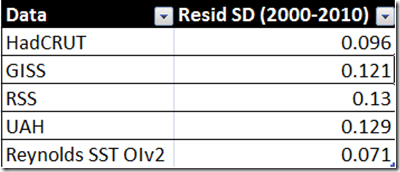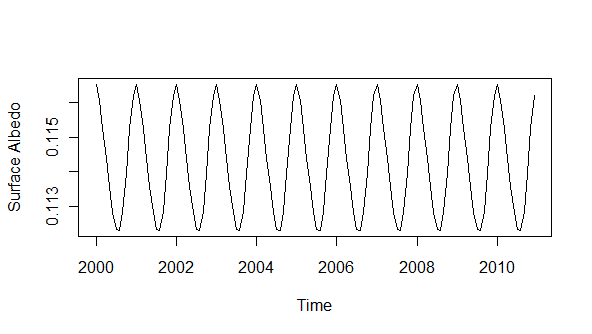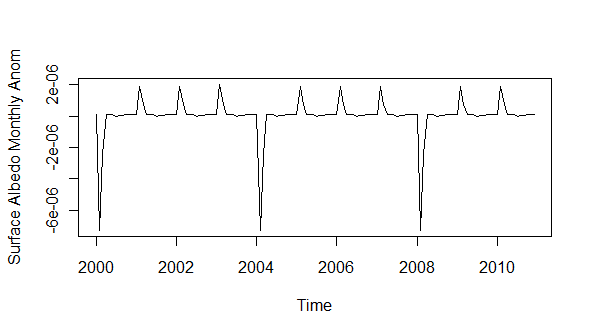Scripts and data for this post are available here.
CERES observation are available here.
CERES water vapor and cloud variables
To continue with the last post, we already know that the bulk of the temperature feedback comes from the atmosphere, not the surface. I thus want to take a quick look here at CERES observations associated with water vapor (total precipitable water) and clouds (area fraction and optical depth) to see whether these too can be better explained using atmospheric temperatures. A quick look at the anomalies for March 2000 through February 2010:
One thing we’ll have to watch out for in calculating our correlations is the strong temporal trend associated with the cloud optical depth. Here is a graph of simple correlations calculated between the temperature sets and the CERES variables shown above:
From this, cloud area fraction clearly shows a better correlation with the atmospheric temperatures than the others. However, due to the strong trend in optical depth it is not as clear cut, and the auto-correlation in total precipitable water makes it difficult to tell the best temperature index, so we’ll look at the first order differences:
There is not a super high correlation with any of these, but to the degree that it is there, clearly the UAH and RSS datasets are the highest.
Radiative Kernels
I’ve also calculated the flux contributions of each type of feedback using radiative kernels. This is a process I started a while back, prior to looking at this particular aspect, and is responsible for creating the largest R script I’ve ever written. A more in-depth description (using model data) is available here, and a helpful guide here. The basic idea is that a model is used to calculate ahead of time radiative kernels (such as those I used from Karen Shell ), which describe what each climate variable (temperature, specific humidity, albedo, etc) contributes to the TOA flux at each grid point. These can be 2D (only lat and lon) kernels such as surface temperature and albedo, or 3D (water vapor, atmospheric temperature), which include an altitude coordinate described by the pressure level. But these models do NOT calculate how much those variables actually change with respect to time/temperature. For that, taking a page from the Dessler10 paper, I use the ERA interim reanalysis data as "observations", and multiple the anomalies of the climate variables by the kernels. We are deviating a bit from true observations here, and personally I think the reanalysis data at individual grid points might be more suspect than the kernels, so make of it what you will.
The ultimate result is the "GlobalFluxContributions" text file included. To run the script, you’ll need to first download the ERA-interim data for BOTH the surface (temperature and albedo) and the atmosphere (relative humidity, temperature, specific humidity) at the pressure levels from 100 to 1000 described in the kernel guide above, and then rename them to match the two early references in the script. You’ll also need to download the Shell kernels linked to above. One thing I should also mention is that when integrating the vertical component of the kernels, they are given in units of 100 hPa.
Anyhow, here is a graph of the flux contributions in time:
Clearly, the feedback that comes from the atmosphere in response to temperature is much larger than that from the surface. One thing to notice is that the albedo line seems flat. As I mentioned in my previous ERA post, this is because the ERA values for surface albedo only seem to have an annual cycle, and do not provide any interannual differences. This is something we’ll need to keep in mind when calculating the cloud radiative forcing later. For now, however, we can take a look at estimates of the water vapor and temperature feedbacks using the different temperature indices.
First, a mention of the variance issue mentioned by TTCA. The following is a table of the standard deviation of the residuals of a linear regression against time:
From here on out, I’ll show the "variance normalized" calculations for feedback, where I assume the standard deviation for some "actual" surface temperature is 0.11, in the middle of the HadCRUT and GISS values. Note that this choice DOES affect what we determine to be our actual feedback values, but is not crucial when comparing the magnitude of the feedbacks of one temperature index against another.
For water vapor feedbacks, we get the following table:
Interestingly, using the normal surface temperatures gives both a worse correlation AND a slight underestimate of the positive feedback, even when normalized. This, however, should not be particularly surprising, given the stronger correlation we saw above between water vapor and atmospheric temperatures.
For the temperature feedback, once again we get a better correlation and larger estimate using the atmospheric temperatures:
However, it’s important to note that the temperature response is directly related to the temperature observations used (in this case ERA-interim), so we’re more likely to get a higher correlation based on how close the ERA observations match the other indices. And yet, assuming that the ERA-interim reanalysis does provide realistic atmospheric observations, we see that using surface temperatures WILL underestimate the temperature response / lapse rate feedback.
To me, the issues of underestimating feedbacks by using surface temperatures seems pretty clear cut, and that whatever other problems with the simple energy balance model, using atmospheric (TLT) temps seems a step in the right direction.

















